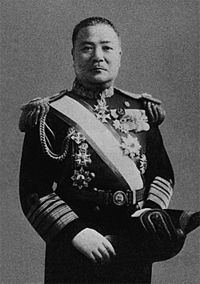 | ||
Died 4 July 1962, Setagaya, Tokyo, Japan | ||
Seizō Kobayashi (Japanese: 小林躋造, October 1, 1877 – July 4, 1962) was a Japanese naval commander, commander of the Combined Fleet of the Imperial Japanese Navy (1931–1933) and the 17th Governor-General of Taiwan (1936–1940).
Contents
Early life and career
Kobayashi was born in 1877 in Hiroshima and pursued a naval career. After graduating from the Imperial Naval Academy with honors, in 1898 Kobayashi first served as an ensign on the corvette Hiei and by 1900 was promoted as a second lieutenant on the battleship Hatsuse. In the years 1902-1905 he was an artillery officer in the cruiser Naniwa and in 1912 was seconded to serve as an officer on HMS Collingwood. In 1917 he was promoted to commander and took command of the cruiser Hirado. In 1920, Kobayashi was appointed Naval attaché to the Imperial Japanese Embassy in London, and was appointed to the rank of Rear Admiral in 1922. In 1928, by now a Vice Admiral, Kobayashi commanded a naval squadron on board Izumo that visited Sydney Harbour, being the fourth time he had visited Sydney, and was received by the Governor of NSW, Sir Dudley de Chair, with whom he had served together on HMS Collingwood.
During the First World War Kobayashi was awarded the US Navy Cross, for his actions in support of the Allied fleet, and with the end of the war he served on the committee tasked with the disposal of enemy naval vessels and was Japan's chief naval expert at the 1927 Geneva Naval Conference tasked with arms limitations. In June 1930, he was appointed Deputy Minister of Navy and in December 1931 was appointed as the Commander of the Combined Fleet of the Imperial Japanese Navy. His promotion to Admiral was confirmed on 1 March 1933. In March 1936, in the aftermath of the February 26 Incident, Kobayashi was transferred to the Naval reserve and was appointed as Governor-General of Taiwan on 2 September 1936.
Governor-General of Taiwan
As the first military governor after a long period of the rule of civilian governors, Koobayashi followed a policy of "Japanization", believing that the colonial status should be abolished in favour of removing the distinction between the Taiwanese and the Japanese on the island and making the territory a fundamental part of the Japan homeland. As Governor-General, in April 1937 Kobayashi ordered the banning of all the Chinese-language media in the colony, with the supremacy of the Japanese language being confirmed, a policy that was soon followed in the colony's schools. This policy was termed kōminka undō (皇民化運動), which roughly meant a "campaign to transform [the conquered people] into the subjects of the emperor". This new aggressive colonial policy also necessitated the imposition of State Shinto and bans on traditional Chinese festivals and customs. With the start of the Pacific War in 1941, Kobayashi oversaw the beginnings of the Greater East Asia Co-Prosperity Sphere in the colony and the end of its colonial status as an integral part of the Japanese home islands.
Later life and career
After resigning from the post of governor in August 1944 became a senator, and in December received a ministerial portfolio, which resigned in March 1945. In February 1946 stepped down from his position as a senator.
